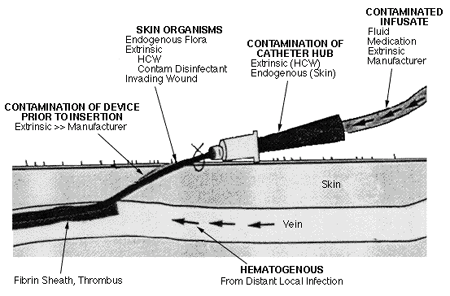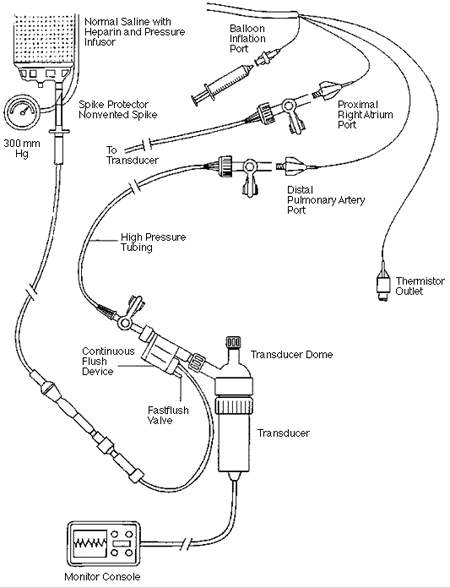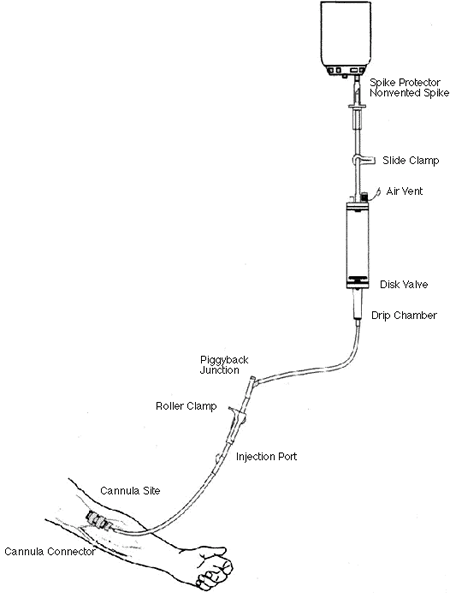|
[Table of Contents]
|
|
Canada Communicable Disease Report
- Supplement
Volume: 23S8
December 1997
INFECTION CONTROL GUIDELINES
Preventing Infections Associated with Indwelling Intravascular
Access Devices
Care of Intravascular Therapy System Components
The components of intravascular therapy delivery systems (see Figures
2and 3) can become contaminated, leading to growth
of potential pathogens on the system's inner surfaces(2). Measures
to prevent contamination (asepsis), to prevent growth of contaminants
(antisepsis) and to prevent microbial growth from reaching dangerous levels
are proven methods to prevent intravascular device-associated infections.
Complex intravascular systems, such as pressure monitoring systems, present
more opportunities for contamination and are well documented as reservoirs
of infection(79,80). Various guidelines have been issued(81).
Current data indicate that for most purposes 72 hours is a safe duration
of use. Longer durations may become acceptable if proven equally safe.
Recent studies have suggested that the use of needle-less injection systems
may compromise the sterility of the lumenal contents of the injection
port (Figure 3) and lead to an increased risk of intravascular-device
related infections(82,83). Further evaluation of these devices
is required. Data regarding use of materials for longer than 72 hours
are discussed in detail in the recommendations.
RECOMMENDATIONS
Administration Sets and Delivery Systems
-
With six exceptions, all intravascular delivery system components
up to the hub should be changed at 72 hour intervals(84-87).
This applies to all intravascular lines, including those used for
total parenteral nutrition. Scheduled changes should be planned to
minimize the number of times that the closed fluid path is opened.
(Category A; Grade I)
-
The six exceptions are:
-
administration of blood products (tubing and administration sets
should be changed as soon as possible after administration)(Category
C);
-
administration of lipid emulsion (total system in 24 hours) (Category
B; Grade III);
-
a suspected epidemic of infusion-related septicemia (total system
in 24 hours)(Category B; Grade III);
-
on site compounded solutions or admixtures with a high rate
of contamination (total system in 24 hours) (Category B; Grade
III);
-
arterial pressure monitoring, for which 96 hours is acceptable
(see Section D below) (Category B; Grade II); and
-
administration of commercially prepared admixtures (recommendations
of the manufacturers to be followed) (Category C).
-
Solutions other than blood, blood components, lipids, or those with
time-limited stability should be completely used or discarded at the
time of delivery system change (72 hours). If excessive infection
rates appear to be associated with fluid contamination, then all solutions
should be completely used or discarded within 24 hours of starting
the infusion. (Category A; Grade III)
-
Blood specimens should not be drawn through single-lumen peripheral
or central venous lines intended for infusions except when essential
to obtain a specimen or when catheter-associated bacteremia is suspected.
A specific lumen from a multi-lumen line should be dedicated for blood-letting.
(Category B; Grade III)
-
The entire intravascular system (cannula, administration set, and
fluid) should be changed immediately if purulent thrombophlebitis,
cellulitis, or intravascular device-related bacteremia is diagnosed
or strongly suspected in a patient with a peripheral or non-tunnelled
central line (Table 2). If an intravascular system is to be discontinued
because of suspected device-related infection, appropriate cultures
of the fluid and cannula should be obtained. Blood and other clinical
material should also be obtained for culture as appropriate. If infection
is suspected or documented in a patient with a tunnelled central venous
line (CVL) for long-term venous access, depending on the organism
an attempt may be made to treat the infection with antibiotics without
removing the line, provided that the patient remains hemodynamically
stable. (Category A; Grade III)
-
Ideally, sterile components should not be assembled until actually
needed(88). Sterile intravenous equipment components should
be stored in a clean, dry and secure environment without spiking or
priming with intravenous solutions. (Category B; Grade III)
Hubs, Stopcocks and Other Connectors (Figures
1, 2 and 3)
-
Systems should be set up to minimize the numbers of ports, connections,
and blind stagnant columns of fluid as much as possible(24,89,90).
(Category A; Grade II)
-
Staff who have exudative dermatitis or other open lesions should
wear gloves when manipulating intravascular lines and junctions for
the protection of both the patient and themselves(91).
(Category B; Grade III)
-
The frequency of handling and manipulation of the cap should be minimized
to reduce the risk of contamination. The optimal timing for changing
hub caps is not known. (Category C)
-
Any open stopcock or injection port (Figure 3) should be protected
with an appropriate cover. (Category B; Grade III)
-
Injection ports (Figure 3) and stoppers should be decontaminated
with 70% isopropyl alcohol or other appropriate disinfectant (see
Appendix III) prior to puncturing. If iodophors are selected,
a disinfectant rather than an antiseptic formulation should be used(92,93).
Swabs used for skin antisepsis should not be used. The current and
commonly used antiseptic formulations are not considered adequate
for this purpose (concentration: 30-50 mg free iodine/litre). (Category
B; Grade III)
- Novel hub and connector designs that improve the security of junctions
may promote lower risk of infection(94-96). Their evaluation
should be encouraged. (Category C)
- Appropriate alternatives should be used to ensure safety in providing
intravascular therapy when latex allergy is of concern(97).
(Category B; Grade III)
Filters
- In line filters should not be used as an infection prevention measure(98,99).
(Category E; Grade II)
Pressure Transducers
-
If disposable transducers (see Appendix III)
and chamber-domes (Figure 2) are used for hemodynamic
monitoring, there appears to be no need to replace the entire transducer
assembly or other delivery system components, including flush solutions,
more frequently than every 4 days(41), and it may be safe
to adopt a "no-routine change" policy(100). (Category
B; Grade II)
-
Reusable intravascular pressure transducers and domes should be sterilized
between uses(101-105). (Category A; Grade II)
-
Ideally, sterile components should not be assembled until actually
needed. When assembled, the space between the transducer head and
dome membrane (see Figure 2) should be left dry
or, if fluid is required, filled with bacteriostatic normal saline,
bacteriostatic water, or 70% alcohol (if this will not cause damage).
Glucose-containing solutions should not be used. If equipment must
be assembled in advance of use, equipment should be stored in a clean,
dry and secure environment. (Category B; Grade III)
-
The patency of pressure-monitoring cannulae should be maintained
through use of a closed flush system rather than use of a syringe
and stopcock. (Category B; Grade III)
Admixture of Solutions
-
Parenteral fluids should be admixed (compounded) using the equivalent
of the good manufacturing practices that are standard in commercial
preparation of pharmaceuticals. These include aseptic technique, a
closed fluid path, terminal filtration with positive rather than negative
pressure, and appropriate laminar flow. (Category B; Grade III)
-
All containers of parenteral fluid should be checked for visible
turbidity, leaks, cracks, particulate matter, and expiry date before
use. If a problem is found, it should be reported to the appropriate
authority and the fluid should not be used. (Category B; Grade
III)
-
Injection ports (Figure 3) and stoppers should be decontaminated
with 70% isopropyl alcohol or other appropriate disinfectant prior
to puncturing. If iodophors are selected, a disinfectant rather than
an antiseptic formulation should be used(92). The current
and commonly used antiseptic formulations (concentration: 30-50 mg
free iodine/litre) are not considered adequate for this purpose. Clean
vial stoppers may be wiped with alcohol(106). (Category
B; Grade III)
-
Single-use containers should be used for admixture whenever possible.
(Category B; Grade III)
-
A distinctive supplementary label should be attached to each admixed
parenteral fluid giving, as a minimum, the additives and their dosage,
the date and time of compounding, the expiration time, and the person
who did the compounding. (Category B; Grade III)
-
Routine culture of parenteral fluids, as a check on sterility, should
not be adopted as an infection prevention measure. (Category D;
Grade III)
-
Admixed parenteral fluids not used immediately should be stored at
4° C. They may be used for up to 1 week unless a shorter duration
is indicated by drug instability(107). (Category B;
Grade III)
Other Sources of Contamination
Bacteremia has been attributed to contamination from ice used to chill
syringes that were used to sample blood from stopcocks(108).
Ice used for this purpose should not be brought to the bedside. Other
outbreaks were attributed to contaminated fluids used to flush central
lines(109,110) and to reuse of pre-filled retrograde medication
syringes(111). Care should be taken to avoid contamination
in the storage and use of any devices and supplies associated with intravascular
care. (Category A; Grade II)
Figure 1
Sources of infection of a percutaneous intravascular device(2).
(Figure is used with permission of author and publisher.)
Figure 2
Components of pressure monitoring system

Figure 3
Diagram of IV tubing containing IV fluid roller clamp, injection port
and IV cannula

[Previous]
[Table of Contents] [Next]
|
![]()





